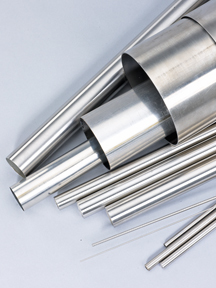
There are many different types of stainless steel used by fabricators and manufacturers around the globe. An exceptionally versatile material, stainless steel is composed of several families of steel defined by a combination of alloying elements and the crystalline structures that shape the properties of the material. Additionally, among these families of stainless steel, there are over 150 grades, each with its own unique combination of alloying metals.
What Are Stainless Steels?
Stainless steels are iron-based, low-carbon alloys that must contain a minimum chromium content of 10.5%. The addition of chromium forms a protective oxide layer on the surface, providing the steels with their well-known property of corrosion resistance. These grades are designated for specific purposes and applications, and they share some common characteristics, such as corrosion resistance and durability.
Stainless steel is classified into different families based on their specific properties and the ratio of various metals in the alloy. The most prevalent families of stainless steel are austenitic, ferritic, martensitic, duplex, and precipitation-hardening. However, it is the grading system that ultimately distinguishes one type of stainless steel from another. In North America, the Society of Automotive Engineers (SAE) has developed a standard alloy numbering system using a three-digit identifier. Recognizable stainless steel grades like the 300 series or 400 series are from the SAE steel grade system. Another grading system was developed by the American Society for Testing and Materials (ASTM) using a six-character identifier known as the Unified Number System (UNS).
The different types of stainless steel have varying compositions and properties which determine their suitability for specific applications. The many grades of stainless steel are used to describe the specific properties required for different applications. The addition of elements such as chromium, molybdenum, nickel, cobalt, and magnesium can enhance these properties further.
Stainless Steel Families and Grades Decoded
Pairing a family and grade together in stainless steel gives a good indication of the performance properties to expect from that specific combination of alloys. This includes factors such as its strength, degree of corrosion resistance, magnetism, and heat resistance. Here’s what to expect within each family of stainless steel as well as common grades and applications found in each.
Austenitic
The most common family of stainless steel is austenitic, which is characterized by its high corrosion resistance, high-temperature performance, non-magnetic properties (in its annealed state), and excellent formability and weldability. Austenitic stainless steels are composed of high levels of chromium and nickel and low levels of carbon, with the predominant crystal structure being austenite. Common grades include 303, 304, 316, 310, and 321, and are widely used in applications where corrosion resistance and versatility are essential, such as in the food industry, chemical processing, and architectural projects.
Ferritic
The second most common form of stainless steel is ferritic. It is characterized by a body-centered cubic crystal structure, which imparts high strength and good corrosion resistance to the material. Ferritic stainless steels have a high chromium content, typically in the range of 10-30%, with low carbon and nickel content. These steels are magnetic and exhibit excellent resistance to corrosion in various environments, particularly in mildly corrosive and high-temperature conditions. Ferritic stainless steel is commonly used in applications where strength, heat resistance, and corrosion resistance are important, such as automotive exhaust systems, kitchen appliances, and architectural structures. Common grades of ferritic stainless steel include 409 and 430 grades.
Martensitic
Martensitic stainless steels are named for their crystal structure formed through a process called martensitic transformation. Characterized by high strength, hardness, and wear resistance, the primary alloying element in martensitic stainless steel is chromium, typically ranging from 10.5% to 18%, with a carbon content that may exceed 1.2%. Martensitic stainless steels are magnetic and offer good corrosion resistance, but their corrosion resistance is generally lower than that of austenitic or ferritic stainless steels. Grade 410, 420C, and 431 are common martensitic types of stainless steel that are used for such applications as cutlery, surgical instruments, industrial blades, and some aerospace components where a combination of high strength, hardness, and corrosion resistance is required.
Duplex
Duplex stainless steels combine the properties of both austenitic and ferritic stainless steels. The term “duplex” refers to the dual-phase austenitic and ferritic microstructure present in these alloys. Duplex steels contain higher percentages of chromium, in the range of 21%-27%, up to 5% higher molybdenum, and a nickel content of up to 9%, among other elements. The combination gives duplex steels higher strength as well as excellent corrosion resistance suitable for challenging conditions, such as in chemical processing, in the construction of storage tanks and containers for shipping chemicals, oil and gas, marine engineering, and desalination plants. The duplex-grade family is based on a wide range of specific formulations, with two of the more common grades S31803 (2205) and S32750 (2507).
Precipitation-Hardening
Precipitation-hardening stainless steel, often referred to as PH stainless steel or age-hardening stainless steel, describes a heat treatment method that is applied to increase the yield strength of stainless steel. Precipitation-hardening stainless steels offer a combination of high strength, corrosion resistance, and good toughness. One common PH grade is 17-7, which offers exceptional strength and hardness, along with good corrosion resistance, fatigue properties, and formability. The number is not designated on the older SAE grade system but is named for its 17% chromium and 7% nickel content, among other alloys. This stainless steel grade alloy offers properties well suited for applications in aerospace and automotive components, or high-performance structural parts used in chemical processing industries.
Contact the Stainless Steel Experts at Eagle Stainless
Eagle Stainless Tube & Fabrication is an industry leader and supplier of ultra-high precision, cut-to-length, stainless steel tubes and bars. We use the latest technology to create unparalleled, state-of-the-art solutions for each of our customers. For more information on which family and grade of stainless steel are best suited for your application, contact us at Eagle Stainless today.



